In The Age Of Reclaimed Girlhood, American Girl Shines
- Oops!Something went wrong.Please try again later.
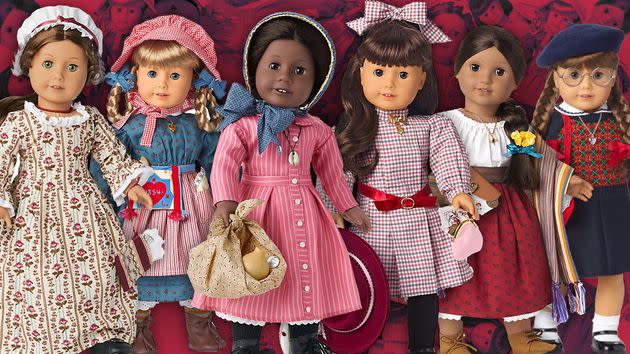
“I’m a Samantha.”
This type of declaration is often a reference to Kim Cattrall’s character, Samantha Jones, on “Sex and the City,” but in certain circles, it evokes another stylish New York lady: American Girl doll Samantha Parkington.
Samantha was one of the three original dolls in Pleasant Rowland’s seminal American Girl line. Inspired by a trip to Colonial Williamsburg and a disappointing experience shopping for her 8- and 10-year-old nieces, the former teacher and textbook author dreamed up a collection of dolls representing young girls from different eras of American history. Each one would come with authentic period outfits and accessories, as well as a series of books about the life she lived at that time.
After founding her eponymous Pleasant Company, Rowland released the first three 18-inch American Girl dolls in 1986 with the Progressive Era aristocrat Samantha, 19th-century Swedish immigrant pioneer Kirsten Larson and spunky World War II patriot Molly McIntire.
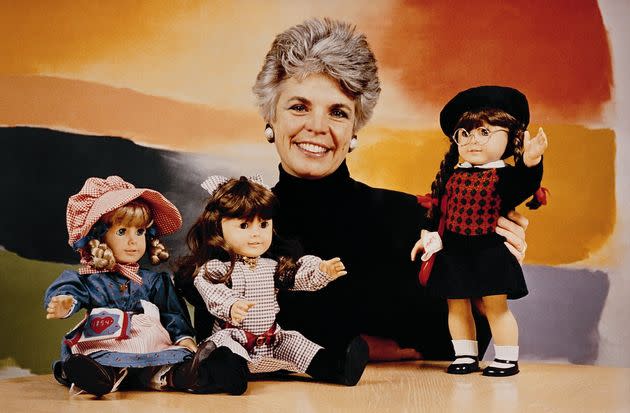
Rowland with original American Girl dolls: Kirsten, Samantha and Molly.
The line later expanded in the 1990s with Felicity Merriman of Colonial Williamsburg and its first non-white dolls: Addy Walker, who escaped slavery in North Carolina during the Civil War, and Josefina Montoya, an early 1800s girl living in what would become New Mexico. With each addition came a new series of books, furniture, accessories and even human-sized clothes so that girls could match their beloveddolls.
The brand developed further with an“American Girl of Today” option that allowed children to customize their own dolls, plus a bimonthly magazine, computer game, activity kits and a series of educational books about topics like puberty and etiquette. Then came the flagship store, complete with a doll hospital, salon, cafe and theater showing stage adaptations of the original books.
“I jokingly say that it’s like a cult because it wasn’t just about having a doll,” Emilee Shield, an artist who sometimes cosplays as American Girl characters, told HuffPost. “It took over your whole life, like I got a doll and I just read six books about this girl and I have a subscription to the magazine and here’s the movie and here are all the lifestyle books and the trading cards and accessories. It’s very easy for it to touch so many different parts of your life.”
As the characters were meant to be 9-year-old girls, the children who played with American Girl dolls and read the books could feel as though they were peers. This sense of connection served Rowland’s goal of inspiring an interest in history in young kids by helping them recognize the role they too could play in the story of America.
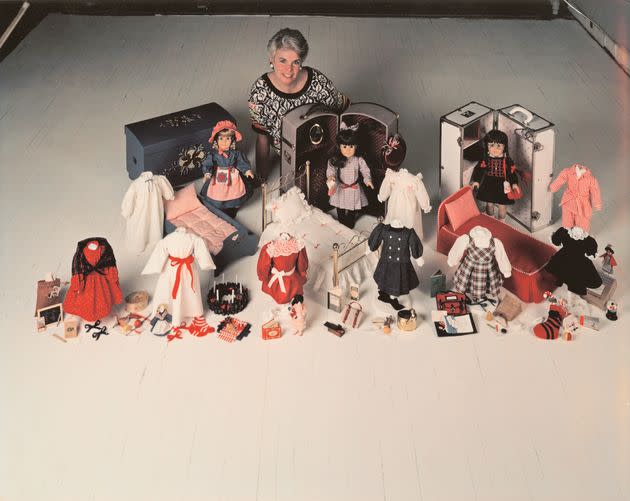
Rowland with original American Girl dolls and their period outfits and accessories.
“American Girl dolls were always my favorite because of the expansive world that the company created with the books and the accessories and outfits,” said Meilan Solly, who connected her early love of the brand to her job as a history editor at Smithsonian Magazine. “I really felt like the dolls were my friends and I could pretend that I was part of their world too. It just meant so much to me.”
“There was an opportunity to not only project onto a doll, but to identify with the doll and her specific story,” addedRachelle Hampton, a culture writer at Slate and co-host of the “ICYMI” podcast. “And I think it was one of the more fully fleshed-out stories of any doll of that era. It perfectly hit the kind of kid who a teacher would say is ‘a pleasure to have in class.’”
Rowland sold the Pleasant Company to Mattel in 1998 for $700 million and retired from the board about two years later. She has since focused on philanthropy and a somewhat controversial project involving the restoration of a town in upstate New York.
But while Rowland has long left the brand behind, the legions of kids who grew up with American Girl have decidedly not. As adults, many continue to collect the dolls, even featuring them in stop-motion videos and photography series. Others launched blogs or created digital museums and archives. There are multiple American Girl-themedpodcasts and meme accounts that pair images of the characters with political commentary and references to contemporary cultural moments.
“Saturday Night Live” produced two comedysketches centered around the dolls just this year, and influencers use meals at the American Girl Cafe as content opportunities. When the accessories brand Stoney Clover Lane released a product line inspired by the original historical dolls’ outfits, many of the items sold out within 15 minutes.
As a millennial woman working in Midtown Manhattan, I often pass the American Girl store at Rockefeller Center and suddenly feel like my childhood self, yearning to go inside and examine every doll and outfit before taking a carefully curated selection (or chaotic bundle) to the register. I’ve learned I’m hardly alone in this impulse.
In recent years, those who connected with the brand in their youth are embracing American Girl nostalgia with the confidence ― and budget ― of their adulthood.
American Girl’s persistence in the cultural consciousness is a reflection of the brand’s staying power with millennial women in particular. In the aftermath of the “Barbie” movie’s overwhelming box office success, we’veseencriesof “Now do American Girl next!”
While the current interest in American Girl might be spurred by the digital nostalgia machine, there’s an even deeper meaning behind the funny memes, pop culture references and snarky blog posts. The power of the brand is how it shaped so many women’s understanding of girlhood and femininity, of history, politics and civic engagement. A large number can even trace their career paths back to their AG fandom.
Amid this powerful endurance, however, are some more difficult realities ― like the brand’s exclusionary price point, shortcomings in racial representation and indoctrination of consumerism in young children. As American Girl finds a second life of sorts with nostalgia-hungry millennials, it’s also worth considering what the formative brand’s influence means in a contemporary context.
The enduring love many still feel for American Girl is consistent with a phenomenon that’s come to the forefront in 2023 ― a reclaiming of girlhood in the public imagination. Just look at the pink-tinted frenzy around the “Barbie” movie or the hordes of women dressing up, making friendship bracelets and dancing around at Taylor Swift’s Eras Tour. Fashion brands like Selkie, Susan Alexandra and Sandy Liang have also brought whimsical girlishness to the runways and the streets.
This sense of unbridled joy and celebration of femininity is part of what drew many fans to American Girl and keeps them engaged with the brand.
“It gave me this sort of fantasy of this world for girls that I really relished,” Shield said. “It’s kind of that idea of the girls’ bathroom in a bar or a club late at night where everyone’s hyping each other up and just very positive. It’s that same vibe and feeling of a safe space.”
In an age when stereotypically “boyish” interests like Comic-Con and esports are massive industries dominated by adults, it feels like a double standard that things more traditionally associated with girls don’t get as much respect. More so than not being normalized, the idea of grown women who still have dolls remains somewhat stigmatized. The contrast is perhaps unsurprising given the societal expectation that girls should put away childish things and behave in a more mature and responsible way at an earlier age compared to their male counterparts.
“Even when I became the age where society starts to tell girls you shouldn’t be playing with dolls anymore, I still was interested in them, so I kept my American Girl dolls although I’d stopped playing with them,” said Rebekkah Rubin, a public historian who runs a history-themed American Girl Instagram account (and coincidentally shares her name with a later historical character). “As an adult, I realized there’s no reason why women can’t continue to collect dolls the way that many people who identify as men have their comic books and action figures and video games.”
Not forcing girls to grow up too soon was part of Rowland’s goal when she founded American Girl, which offered an alternative to the baby dolls that placed children in a mothering role and the more mature figure of Barbie. As she told CNN in 2002, “Here I was, in a generation of women at the forefront of redefining women’s roles, and yet our daughters were playing with dolls that celebrated being a teen queen or a mommy.”
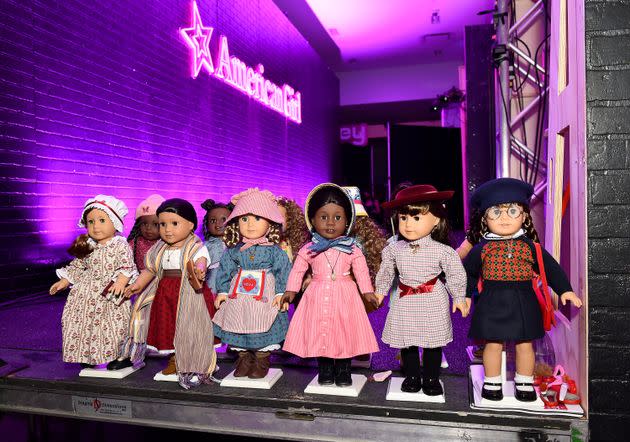
Dolls on display at American Girl Place in New York City on September 23, 2021.
Communications and media professor Emilie Zaslow, who has written extensively about American Girl and its roots in second-wave feminism, believes the brand toes an interesting line between progressive ideals and traditional values.
“They started out using an approach to marketing that was like, protecting girls from this more sexualized culture that was entering pop culture in the late 1980s with Madonna, Cyndi Lauper and Salt-N-Pepa,” she explained. “So there was this female empowerment message that girls can do anything, but also it’s steeped in this kind of neo-traditionalism.”
In contrast to Barbie, the American Girl world was also less about all things pink and pretty. While the clothing and aesthetics were part of it, fans of the brand felt an emotional connection to the characters’ books, which were filled with stories of bravery, friendship and a surprising amount of trauma.
Kirsten’s best friend Marta dies of cholera. Josefina and Samantha are both mourning dead parents. And Addy endures abuse at the hand of an overseer, copes with painful memories of her brother’s brutal whipping and is separated from most of her family when she escapes with her mother in a harrowing journey to freedom ― all in just the first book of her series.
“Some other books I read as a kid were almost patronizing in how simple the stories were,” said Paige Davanzo, who started collecting the dolls when she was 7 and now runs a blog about American Girl. “Reading the American Girl doll books kind of shined the light on some great things and progress in our history, but in other ways, they really showcased the things in our history that are just atrocious.”
Indeed, Barbie never had a friend who died of cholera, but maybe the horrors in the American Girl books established a sort of emotional trauma bond between girls and their dolls that led to a deeper and longer-lasting connection.
“I wanted the reader to feel, ‘OK, I’m being respected by the person who’s writing this book,’” explained Valerie Tripp, the prolific author behind all of the books in the original Molly, Felicity, Josefina, Kit and Maryellen series and three of the books in the Samantha series.
“And this person and these books are telling me to pay attention, be observant, be curious and be active,” Tripp continued. “Very hard things happen to the characters because there are always going to be disappointments and changes in life, but you’re going to be OK. So there’s an underlying theme of optimism, hope and possibility, which I think is important for a child.”
The American Girl books couldn’t get too gratuitous in showcasing the horrors of the past due to the young age of the target reader. Tara Strauch, who teaches an American Girl-centered history course at Centre College in Kentucky, believes there was some sugarcoating of U.S. history and a limit on the stories that could be told.
“It hints at the cruelties of the past, but because the books are aimed at 7- to 10-year-old girls, it can’t show them on any large scale,” she said. “And although the characters are put into terrible positions, like watching a friend die or a parent lose their job, nothing too bad can happen to the girls themselves. One of the jokes my students make is that you can’t have a Triangle Shirtwaist Factory Fire doll.”
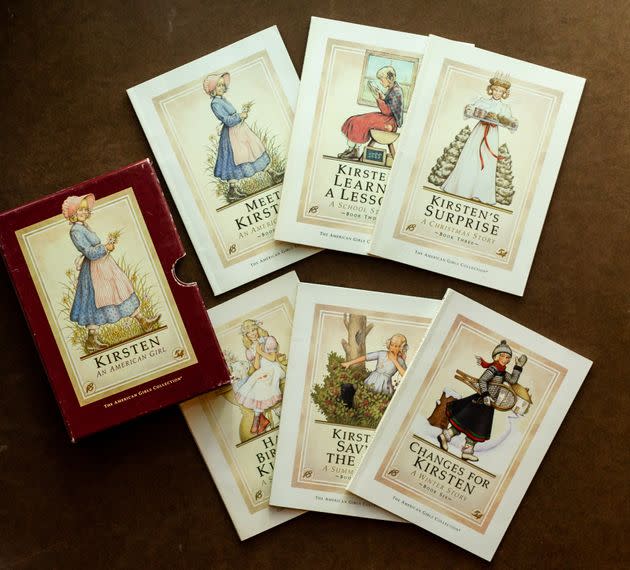
The six books in Kirsten's original series.
Since the Mattel acquisition, the brand seems to have shifted its focus away from historical characters and more toward the “American Girl of Today” (now called “Truly Me”) dolls and the “Girl of the Year,” an annual limited-edition character whose story takes place in the present day.
As the older dolls were archived, those who grew up reading about the struggles of pioneer families and Great Depression-era children complained that the newer characters’ “first-world problems” were lacking in substance. Instead of deadly disease, war and family separation, you’ve got ’90s doll Nicki Hoffman fretting over Y2K.
In tandem with these substantive changes, there have been aesthetic shifts as well.
“Pink is one of my favorite colors, but American Girl is starting to get into a little too much pink and purple,” said Kristen Washington, a theater teacher and collector who co-hosts the “American Girl Fan Club” podcast. “I understand they’re probably trying to attract younger generations, but I think they’re forgetting why people loved it. It’s not that pink everything, bubblegum-y joy thing that Barbie has ― it’s very different.”
And the pinkification is not limited to new characters and contemporary dolls. In 2014, the brand released updated versions of its historical dolls, rebranded as the BeForever collection. As part of the redesign, OG dolls like Samantha and Addy got a wardrobe makeover with an emphasis on brighter colors ― new looks that some fans criticized as “garish” and not historically accurate. The accompanying books were also condensed from a series of six into two volumes with the original illustrations removed.
“To me, the message behind what they’re selling right now is a reinvestment in the traditional norms of a stereotypical girl experience, which revolves around aesthetics, beauty and hair culture, bedroom culture, colors like pink and purple and repositioning girls in the private sphere,” Zaslow said.
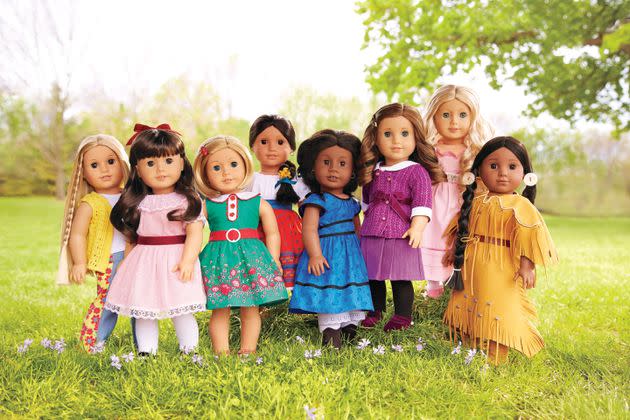
American Girl's released its redesigned BeForever line in 2014.
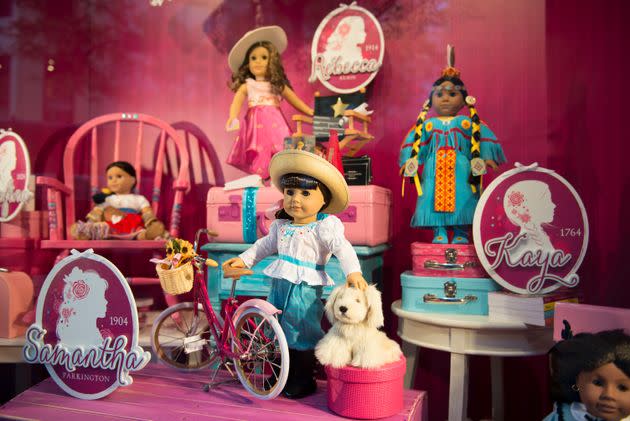
The recent approach to American Girl branding has involved brighter colors.
This more limiting approach to girlhood stands in contrast to the books’ storylines, which include aspects of domesticity but also emphasize civic engagement, social change and the power of using your voice. In a world where history is often presented from the perspective of men in writing geared toward male-identifying audiences, American Girl took a different approach ― one later seen in Scholastic’s popular “Dear America” novels, which debuted in 1996.
“There’s no doubt that those books planted a seed that girls mattered in a way that children’s literature and historical fiction wasn’t necessarily doing beforehand,” Strauch said. “These girls have problems, and they solve them themselves. And the end of the books often had these sections connecting these girls into larger bits of history, so they were clearly making the case that these girls didn’t just matter in their families or with their friends ― these girls mattered as Americans. And that was very influential for me ― the idea that I wasn’t just living a life for myself, but that I mattered.”
For Tripp and the other book authors, the hope was that this awareness would impel to action and inspire girls to stand up for their beliefs. The character of Samantha, for example, famously delivers a speech about the horrors of child labor after her friend Nellie shares the dark reality of working in a factory. More recently, Melody Ellison, a Civil Rights Movement era character introduced in 2016, closes her account at a bank that refuses to hire her sister because she is Black.
“American Girl welcomed girls into American history as readers, but also as agents of change inside of American history,” Zaslow said. “So from the very beginning, all of the stories had girls who were civically engaged ― they were using their time, their voices and their energy to make change. And we can talk about how it wasn’t always equitable or how the brand might’ve done things differently, but from the very beginning, the girl characters stood up for a sense of justice in America, that America not only wasn’t perfect, but needed change on an institutional and policy level. And that girls could be active citizens.”
For many who grew up with American Girl, that seed of civic engagement has blossomed into a passion for politics and nonprofit work. The founders of the popular @hellicity_merriman and @klit.klittredge Instagrammeme accounts work in government-related jobs, and they have not shied away from commenting on politicalissuesthroughtheirAmericanGirlmemes, particularly after the Supreme Court’s Dobbs decision overturning Roe v. Wade.
“I’m sad for some of the ways that what it means to be a girl in America hasn’t changed,” Tripp said. “Didn’t we think we had made progress, and don’t we see some of our rights being eroded and taken away from us? So what it means to be an American girl means that you’ve got to be vigilant, and keep an eye on your rights, your right to vote, your right to be in charge of your own body, your right to have any job that you want to have. I have to say, I did not foresee that we’re gonna have to have some of these fights over again.”
Tripp said she was pleased to come across memes of Samantha in relation to the strikes by the Writers Guild of America and Screen Actors Guild-American Federation of Television and Radio Artists.
One thing I know for sure: my Labor Rights Queen would have a fair deal for writers and actors TOMORROW: pic.twitter.com/77rslVJoLu
— Rohita Kadambi (@RohitaKadambi) July 18, 2023
“Absolutely, Samantha would be out there saying, ‘You can’t scare me, I’m working for the union!’” said Tripp, the book author. “I love that. From when they were little girls reading the books till now when they’re grown up, I have been in awe of the connections that the readers make to the stories and the way that people have brought their experience with American Girl into their lives.”
American Girl returned to many adults’ lives amid the isolation and uncertainty of the pandemic, as a large number returned to their childhood homes and reconnected to the things they loved as kids.
“We’re in the era of nostalgia,” Hampton said. “Everything that we loved as kids is not only popular right now, but even multibillion-dollar franchises. So it doesn’t really surprise me that people are getting back into American Girl. And then with the pandemic, I feel like I kind of regressed into a teenager for a little while ― I was going back to things that comforted me when I was younger. And one of those things was American Girl when I found some of the meme accounts.”
American Girl seems to have capitalized on the power of the nostalgia era, rereleasing the original dolls and accessories, launching podcasts hosted by adult fans and collaborating with brands like Stoney Clover Lane and LoveShackFancy.
But for many fans, their love of American Girl isn’t simply about feelings of nostalgia. Several who spoke to HuffPost credited the brand with setting them on their current career paths as filmmakers, theater teachers, historians, costumers, choreographers and writers.
Micah Jeter paid for her college education with the money she earned from her American Girl-themed YouTube channel, where she gained nearly 200,000 subscribers with her stop-motion videos. Her videos ranged from storylines about slumber parties to “day in the life” vlogs to an annual awards show for other “AGTube” creators.
“I always enjoyed making little bedrooms and house sets for my dolls and then just telling stories with them,” Jeter told HuffPost. “And AGTube was an amazing creative outlet. It was great being part of this community where other girls were experimenting with film and photography skills ― we were all doing these clever little things.”
Washington’s podcast co-host Sydney Rose Paulsen parlayed her love of taking pictures of her American Girl dolls into a full-time job as a photographer, even working directly with the brand on product shoots. Actor Brie Larson’s stage name was inspired by her Kirsten Larson American Girl doll.
Sarah Fristoe, whom many AGTubers cite as their first inspiration, launched her channel almost 15 years ago and gained a devoted following with her American Girl music videos, choreographed doll dances, doll hair and DIY clothing tutorials, product reviews and more.
“Some little kids were kind of obsessed with me and my channel, and I became kind of like a celebrity,” she said, recalling how some subscribers would ask to mail her their dolls so that she could sign them. “It started to get to the point where people were borderline stalking me. People found my mom’s home phone number, and called because they knew I lived there.”
After a yearslong hiatus, Fristoe started posting American Girl videos again this year but is mostly focused on raising her two sons and her job as a dance instructor. Although Jeter has stepped away from her AGTube channel, she still works in video production and feels fondly toward her collection of 30 American Girl dolls.
But that impressive number pales in comparison to what other collectors have amassed. Sydney Jean Satalino estimates she has about 180 dolls.
“I pretty much have the entire collection now ― all the Truly Mes, all the historical dolls, all the Girls of the Year,” she said. “I’ve been collecting for years, and a lot of them are hand-me-downs from my sister, and my sister’s friends gave me some dolls and I got a lot of them secondhand off eBay.”
Washington similarly guessed she has around 170 American Girl dolls at present, though she plans to donate many of them to charity. She touted the high quality of the dolls, some of which she hopes to pass down to her future children someday.
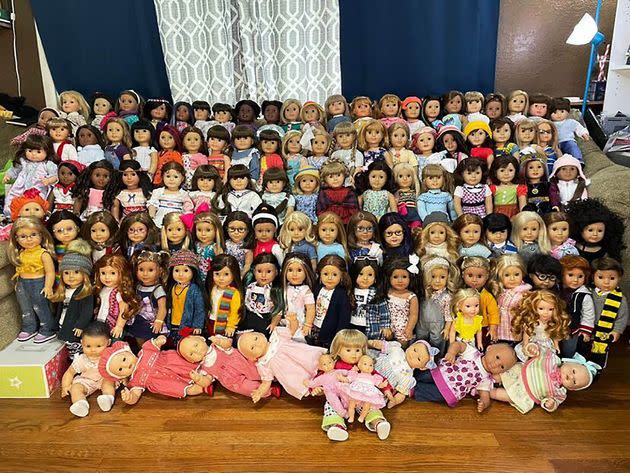
Fristoe estimates she has about 100 dolls in her American Girl collection.
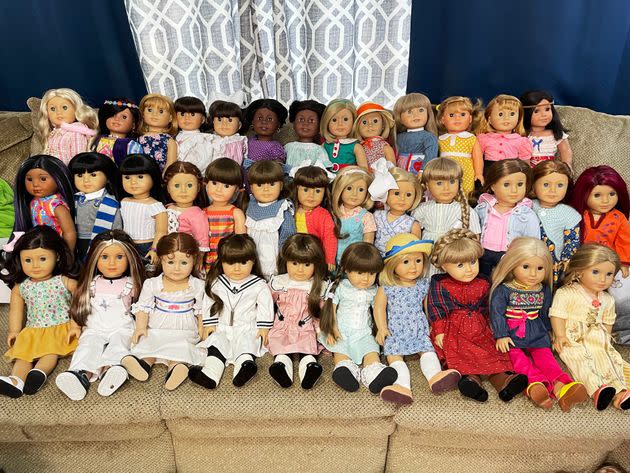
Fristoe's collection of American Girl historical dolls.
Although the AGTube and collector communities offer supportive and positive spaces, there is an inescapable element of what YouTuber Cheyenne Lin describes as American Girl “flex culture.” Fans are often eager to share their latest purchases, which can come with rather hefty price tags. The dolls in American Girl’s recent Disney Princess collection cost $300, while the standard characters retail for $115 ― and that’s not counting additional clothing, furniture and accessories.
“I think it feels competitive because there are people who can afford to have 80 dolls and a dollhouse space and show that, but the majority of the community can’t,” said Eliza Dionisio, creator of the @juuliealbright meme account. “And it becomes a big problem in American Girl social media because people are struggling to try to keep up.”
So yes, the brand might’ve instilled an appreciation for history in those who grew up with the dolls, but perhaps underpinning that mission is an indoctrination of consumerism in its young customers. Throughout the books, readers are treated to detailed descriptions and plot points involving objects of great significance to these characters ― objects that are for sale as American Girl doll accessories. Even the doll characters have their own little dolls (sold separately, of course).
Almost everyone who spoke to HuffPost pointed to the American Girl catalog as a central part of their experience with the brand.
“If there’s one thing that would connect us together, it was those catalogs,” said Blake Changnon, creator of the American Girl-focused digital archive The Changnon Family Museum of Toys and Collectibles. “You got them in the mail and circled or highlighted everything you wanted. It was this shiny catalog that would be losing its mintiness within weeks because of how much time we spent flipping through it.”
The commodity culture reached new heights with the opening of the first American Girl store in Chicago in 1998, which was followed by a New York location in 2003, a Los Angeles shop in 2006 and then a slew of others across the U.S. and beyond.
“There was this kind of contradiction between the storylines of dolls, who would not be able to afford the very things that the families who were buying them could afford,” Zaslow said. “Swedish immigrant Kirsten’s family is struggling, and yet you have to pay almost $1,000 to get her full collection. But she would not have been able to do that ― she had a rag doll.”
As a child of the ’90s, I spent my formative years playing with American Girl dolls, studying every product listed in the catalogs and devouring all the historical fiction and advice books. Going to the newly opened American Girl Place in Chicago felt like entering a dream world, my very own Barbieland.
I was certainly drawn to some products more than others. Samantha’s luxe brass bed and velvet clutch purse with a golden clasp were a little more exciting than say, Kirsten’s wooden spoon.
There’s a lot of complexity to that notion of girlhood that American Girl presented and realizing that this version of girlhood was only available to people who came from a background with the money and access to go to buy all these very expensive accessories.Solly
In a way, American Girl fostered the idea that objects can hold special meaning and value for people and create thoughtful, sensitive consumers. For many adult collectors, there’s a lot of joy in realizing you can now use money that you didn’t have as a child to purchase a doll or accessory you always wanted. But this has its downsides as well.
“I think the American Girl community is a big example of rampant consumerism and sometimes toxic consumerism as well,” Dionisio said. “Some people are trying to be the first to get every new doll and collection in its entirety. I know one collector who was saving to get out of their house because they were in an abusive living situation, but they just couldn’t, because they could not stop buying dolls. They had close to 100 American Girl dolls.”
Fortunately, there are more affordable ways into the world of American Girl. Shield recalled how she and her family made good use of thrifting to build her collection and her mother would photocopy pages of the brand’s lifestyle books at the library. Fristoe learned to make her own doll accessories and outfits and still likes to DIY new products.
Today, libraries even have lending programs that allow kids to borrow historical American Girl dolls and items along with their books. And YouTube is full of videos with tips for refurbishing secondhand dolls in need of a little TLC. But these are relatively recent developments that weren’t available to young customers in the ’80s and ’90s.
“There’s a lot of complexity to that notion of girlhood that American Girl presented and realizing that this version of girlhood was only available to people who came from a background with the money and access to go to buy all these very expensive accessories,” Solly said. “And it is presenting this version of girlhood that isn’t necessarily reflective of the actual diversity of American girls.”
The first four American Girl dolls were notably all white. Much has been written about the fact that the first doll of color, Addy, began her story as an enslaved person.
“Addy’s story, compared to the other girls’ books, is very heavy. I remember rereading it as an adult and thinking, ‘Wow, this is low-key traumatizing,’” said Danielle Lacey, co-host of the “Black Chick Lit” podcast. “You had Samantha, who’s a rich orphan, and Molly’s going to summer camp, and then the Black girl is the one who is forced to eat worms from tobacco leaves.”
A 2017 episode of ABC’s “Black-ish” even parodied American Girl with its “Girl Story” plot point in which a doll brand’s only two Black dolls are a runaway slave and a Civil Rights activist named “Selma.”
“We see a lot of popular narratives centered around Black suffering, and those stories are of course vital ― those are our ancestors and we wouldn’t be here without the resilience of the people who came before us,” said Lacey’s co-host Mollie Cerros. “But we don’t always get to see Black joy. And when I ask my grandma about her experience, there was a lot of joy, and there were shenanigans. I think there’s a balance to be struck, and the answer is just to have a greater abundance of Black storytelling and representation of Black life in this country.”
To develop the Addy doll in the early ’90s, Pleasant Company assembled an impressive advisory board of Black scholars and historians who made decisions ranging from the time period and general plot of her story to the design of her hair and accessories. This background is in part why Hampton believes it’s “very reductive” to refer to Addy simply as “a slave doll” ― especially considering she spends most of her books as part of the free Black community of Philadelphia.
“I definitely understand that perspective of ‘Why did Black girls only have a slave doll to play with?’” the Slate culture writer said. “But any historical doll that was Black was going to engage with some form of oppression or trauma because that’s just the story of Black America. It’s unfortunate, but it’s true. And I think pretending that that’s not real would be a disservice to those Black girls. There’s just no era you’re going to get to where Black people’s lives weren’t touched by oppression.”
Connie Porter, who wrote the Addy books, echoed Hampton’s point. She recalled people who wanted the first Black doll to be set in a different period and asked, “Can’t you pick a happier or more uplifting time?”
“But I’m like, please tell me what that magical day is for Black people in American history,” Porter said. “Maybe it was during the March on Washington, but then you’ve also got Selma, Montgomery, the bombing of the church in Birmingham. Maybe it’s the Harlem Renaissance, but how do you understand that period without thinking about the Great Migration and why Black people moved across America? No matter what story you pick, if you want to explain prejudice, segregation, the social constructs of the time ― you’re going to be pulled back to slavery.”
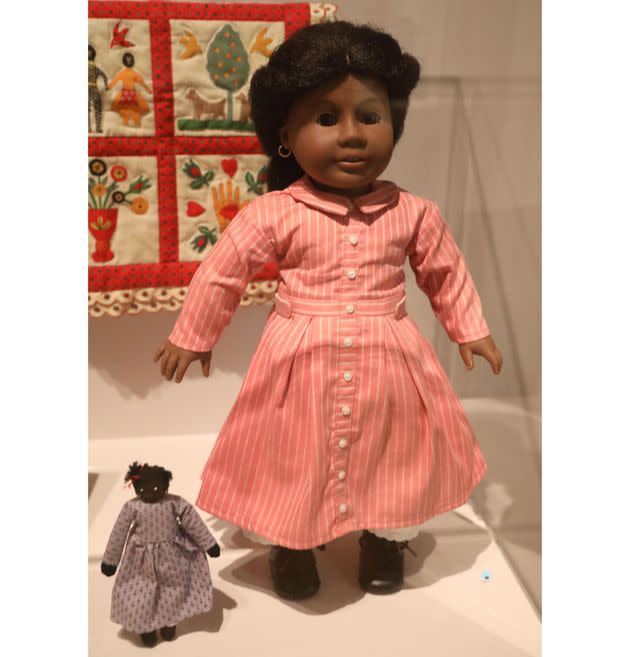
An Addy Walker doll with her doll on display at the New York Historical Society's "Black Dolls" exhibition in 2022.
Overtheyears, many Black writers have shared their complicated relationships with the Addy doll and books. Porter said she tries to read and respond to these essays whenever she can.
“Some people feel conflicted,” the author said. “And I think some of those criticisms are fair. I’m happy to have the conversation as long as people are being fair, they’re being honest and they really read the books ― they didn’t just hear about them.”
Although some people have complained about Addy’s “kinky hair,” Porter emphasized that she and the advisory board went to great lengths to select a coarser hair texture for the Black doll, which they felt was a more authentic representation.
“Overall, It was a hard position for me to be in as an author for Addy to be the first Black character and for Pleasant Company to place her in a story of slavery and have one character to represent the millions of people who were enslaved,” Porter said. “She couldn’t be everything to everybody.”
Multiple scholars who spoke to HuffPost also noted the significance of Addy in leading white families to think more about diversity and the fact that she might’ve been the first Black doll that many of these families purchased.
“I think about the story of Addy a lot, and I think about what people are not learning about slavery now,” said Allison Horrocks, a public historian and co-creator of the “Dolls of Our Lives” podcast and the upcoming book by the same name. “‘Meet Addy’ is a radical book. I think it’s an important book, and I don’t know that it would even get published now or five years ago. To say that Addy Walker is an American Girl just like all these other girls is an important act, and the fact that she’s a girl who frees herself has a lot of radical value for our culture today.”
But contrasting Addy’s story is the uncomfortable fact that the colonial-era character of Felicity has enslaved people in her household and visits her grandfather at his plantation. While Felicity is fixated on liberating a horse, the books don’t consider the freedom of these characters, who are generally described as “servants.”
“I just can’t with the cognitive dissonance,” said Lydia, the creator of the @klit.klittredge meme accounts, who asked that HuffPost not use her last name to protect her privacy. “The Pleasant Company would grapple with telling Addy’s harrowing story of escape from human trafficking, and then meanwhile just keep selling Felicity’s ‘Plantation Play’ stuff.”
Her Twitter account had a viral moment last year after she joined the masses in taking advantage of the social media company’s confusing verification roll-out to buy a checkmark, change her Twitter name to “American Girl” and tweet “Felicity owned slaves.” (Perhaps in part because of that element of Felicity’s story, the doll was archived in 2011 and again in 2019 after a two-year return, though she was part of the limited edition 35th anniversary rerelease in 2021. Her books have been retired as well.)
“Kirsten’s stories are a little problematic too in terms of the Native American character Singing Bird, who has very little voice,” Zaslow said. “She says that her family is being forced off their land, so she has to move. And Kirsten’s basically like, ‘Oh, I’m so jealous that she gets to travel.’ And that’s that.”
She also pointed to the stories of Josefina and Kaya, a Native American doll introduced in 2002, and the fact that their stories seem to be set before white settlers come onto their land.
“So for the most part, we get a sense of a culture that’s free from the harm of racism and white supremacy in those stories,” she said. “I should say the same thing goes for Rebecca Rubin ― we don’t really see antisemitism in her story.”
When you’re a brown kid playing with white dolls and you can’t see yourself on the shelves at the store, it’s sending you a message that you’re an outsider, you’re different, you’re other, you’re not included, you’re not the main event here.Mattai
The American Girl brand has no doubt taken steps to address its earlier shortcomings in terms of race and inclusion. In 2022, it released a new Harlem Renaissance doll, Claudie Wells, whose book series was written by author Brit Bennett. Many fans expressed their delight at Claudie’s joy-filled stories and the decision to hire Bennett, who’d published an essay in the Paris Review on Black dolls, titled “Addy Walker, American Girl.”
Several of the recent “Girl of the Year” dolls have also reflected greater cultural diversity ― like Corinne Tan, who is Chinese American, and Kavi Sharma, who is of Indian descent.
“It seems frivolous, but dolls can be the first sort of line of defense in teaching you how the world works and who’s important,” said Sumitra Mattai, who wrote an essay for HuffPost about the significance of Kavi’s release. “When you’re a brown kid playing with white dolls and you can’t see yourself on the shelves at the store, it’s sending you a message that you’re an outsider, you’re different, you’re other, you’re not included, you’re not the main event here. And that has a subliminal impact that accumulates. It starts with the doll, then it’s commercials, TV shows, everything around you.”
Study after study has shown the power of diversity and representation in dolls. With a weighty brand name like “American Girl,” inclusivity is even more important as it asks young customers to consider what it means to be a girl in America.
“I think that there are a lot of collectors who identify with the kind of nationalism aspect of the name and what it purports to represent,” Rubin said. “And they see the characters as espousing conservative values, a conservative kind of patriotism. But there are also progressive collectors who see themselves and their values. It’s really interesting how the brand is able to walk this line where both conservative and progressive collectors see their values in the books.”
The wide range of ideologies among its consumers has led to a number of controversies for the brand over the years.
In 2005, conservative groups threatened to boycott American Girl over its support of the nonprofit Girls Inc., which the groups claimed was an endorsement of abortion rights and “lesbianism.” A similar boycott was called in 2021 after the introduction of the Girl of the Year, Kira Bailey, whose aunts are a married same-sex couple living in Australia.
“I think the most notable controversy was in 2009 when the Girl of the Year Chrissa’s friend Gwen was homeless,” Satalino said. “They made a doll about her, and it was like ‘Oh my gosh, a $95 homeless doll!’”
The 2005 Girl of the Year, Marisol Luna, prompted criticism from residents of the predominantly Latino neighborhood of Pilsen in Chicago, as they felt her books depicted their community in a negative light and ignored the role of gentrification in displacing its residents. And not everyone was happy in February 2017 when the brand introduced Logan Everett, its first official boy character doll.
“The response from adult women was very mixed, but there was certainly some sense of anger that Logan was like, an interloper into this all-female community,” Zaslow said. “It’s interesting because he was released right after Hillary [Clinton] lost the election and Donald Trump won, so the release was terrible timing for the brand.”
That same month, there was a bigger uproar when American Girl announced that the dolls’ removable underwear would be replaced with permanent underwear sewn directly onto their bodies. The fan reaction was so negative and widespread ― people said it was a bizarre and unnecessary change that diminished the dolls’ quality and sent a body-shaming message to young girls ― that the brand decided to revert back to the original design within two months.
With these frustrations comes the reminder that American Girl is ultimately a business.
“Especially now that they’re owned by Mattel, I think the bottom line is that at the end of the day, they’re trying to sell dolls and make money,” Lydia said. “When we look to brands to find our inspiration or to find what it means to be a girl or what it means to exist in society, I do think that messaging is going to fall kind of flat.”
It’s unclear if American Girl has quite the same hold on younger generations that it did on kids growing up in the ’80s, ’90s and early aughts. Mattel investor presentations show that net sales were down 16% in 2022 compared to the previous year, but they outlined a few strategy shifts aimed at turning the brand into a more consistent performer.
“We are reconnecting the brand to girls and their parents by creating new relevance to drive the cultural conversation,” Mattel’s then-president and chief operating officer, Richard Dickson, said in March.
He also explicitly acknowledged American Girl’s adult fans with a mention of plans to reissue a classic character doll from the archives. Still, young girls remain the core focus of the brand ― even if its monocultural dominance over this age group is a thing of the past.
“From the start, American Girl has been focused on helping girls grow up with courage, confidence and strength of character,” Jamie Cygielman, senior vice president and general manager of American Girl at Mattel, told HuffPost in a statement. “As a brand rooted in story, each of our beloved heroines has helped to create a sense of connection and community among our fans for more than 35 years. And whether we’re developing a modern-day character or one from long ago, our goal is to continue providing engaging, culturally-relevant stories and authentically detailed dolls and accessories that spark imagination and help girls become the strong, compassionate, and resilient women of tomorrow.”

Paulsen parlayed her love of photographing American Girl dolls into a full-time career as a photographer.
Many of the adult fans who spoke to HuffPost believe American Girl was smart in the way it solidified its brand name as a resource for learning how to exist in the world.
“As they made the dolls and stories, they were also making these other books about your changing body and basically like, how to do life for girls,” Strauch said. “I didn’t even like crafts, but I loved the craft books because I liked the idea that someday I would be put together enough to make those crafts. There was this sense that American Girl is going to help me navigate becoming an adult, show me what the right products are and how to wash my face and what’s happening with my body.”
This September marked the 25th anniversary of “The Care and Keeping of You: The Body Book for Girls” ― a revolutionary text about puberty that developed a cult-like following with its refreshingly direct and informative guidance. The number of times I’ve seen peers light up in reminiscence at the mention of this book further highlights the American Girl brand’s remarkable legacy.
“I’m disappointed to discover that as an adult, there is no American Girl guide to how to be a mom and an employee,” Strauch added.
But perhaps grown-ups can move forward with some of the central messages of the American Girl storybooks: Change is inevitable. You don’t need to have everything all figured out. And you can learn from your missteps.
“I think that the brand does a really good job of representing how OK it is to be a child, to explore different facets of oneself and to not be perfect,” @hellicity_merriman co-founder Barrett Adair said. “I think constantly about the early age that girls start being treated like young women in some households and those gendered expectations of girls. And I feel like the American Girl stories were very nice in portraying that you aren’t necessarily more mature than your years and you don’t have to act in a more upstanding way than a boy does.”
“I can see so clearly now in a way I didn’t recognize how useful it is for girls to have a good example of how to embrace themselves fully and feel like a child who is allowed to make mistakes,” Adair continued.
That freedom to make mistakes and grow from them is crucial for developing into a secure and confident adult. And that’s exactly what many grown American Girl fans feel they’ve become.
“What I’ve always preached to people who followed me is just to be yourself and do what you like to do,” Fristoe said. “As long as it’s not hurting anybody then who cares? If you’re a 30-year-old and walking around with an American Girl doll is what brings you joy, then do it.”
And if bringing your doll to the American Girl cafe to enjoy cosmopolitans with your friends à la Samantha Jones makes you happy, then even more power to you.
